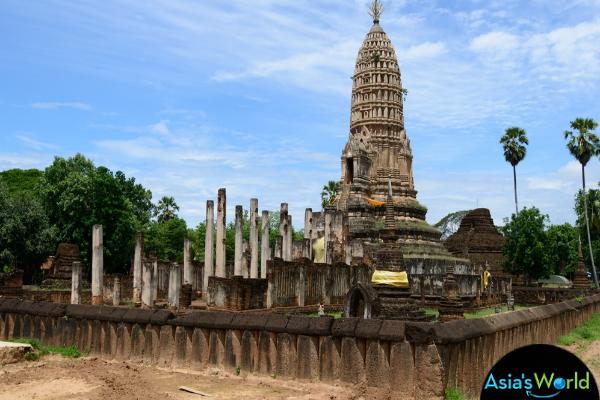Chaliang Si Satchanalai

Wat Si Mahathat Chaliang
- Chaliang (Chalieng) is an ancient settlement which forms part of the total Si Satchanalai Historical Park. Here are the earlier monuments of Mon, Khmer and later Tai styles.
- The Chaliang Site area is small and the monuments valuable to see. The main tourist sites here are, (1) the Chaliang City Wall, (2) Wat Phra Si Ratana Mahathat, (3) Wat Chom Chuen, (4) Wat Noi Cham Pi and (5) Wat Khok Cham Pi, (6) Wat Chao Chan, the Yom River landscapes and (8) Wat Noi.
- The Chaliang Fortifications. The ancient wall fortifications are earthen ramparts and laterite structures. They line the Yom River top embankments. Historians are not certain when the earthen ramparts were first built but archaeologists suggest they are pre Sukhothai period. The laterite walls were added later.
-
Wat Phra Si Mahathat Chaliang (1237) (pictured above) is large and impressive, of Khmer style with early Sukhothai style artistic additions. It is surrounded by a tall thick wall made of laterite blocks. These slabs stand vertically and are close together. They are topped by large horizontal laterite slabs.
- The outer area of this settlement was also surrounded by fortification walls made of laterite. These walls run along the peak of the Yom River banks.
-
King Jayavarman VII of the Khmer Empire was a Mahayana Buddhist and the temple was constructed during his time. Khmer features include Bayon styled roof tiles and laterite foundations. The temple is approached from the east gate entrance. Here today are two images of each of Phra Ruang and Phra Lue the Tai leaders who joined forces to expell the Khmers from the region and establish the cities of Sukhothai and Si Satchanalai. At the entrance to the small entrance is a statue of the four headedBrahma. This is typical of the Bayon style from Angkor and is not found elsewhere in modern Thailand.
- The artistic works are of the Khmer Bayon style (late 12th to early 13th centuries). These include the Brahma image, the celestial style females covered in stucco beneath each of the faces of Brahma, the stucco naga decorations on the laterite columns and the Buddha beneath Naga image in the small shrine to the immediate right side when you first enter the temple grounds.
- Inside the temple grounds one should see each of the following art and architecture ruins. (1) The assembly Hall of Luang Pho To, (2) the walking Buddha Statue, (3) The main Prang as depicted in the pictures on this web page, (4) the seated Buddha Image also depicted here, (5) Phra That Mutao, the ruins of the Mon octagonal Stupa, (6) Mandapa of Phra Attharot which houses the Phr Attarot Buddha image depicted in the image below, and (7) the ruins of Assembly Hall Phra Song Nong.
- The three Buddha images include the seated Buddha image shown here at the rear of the Assembly Hall of Luang Pho To, the standing Buddha of Phra Attarot and the walking Buddha to the left side of the seated Buddha.

Chaliang Temple







